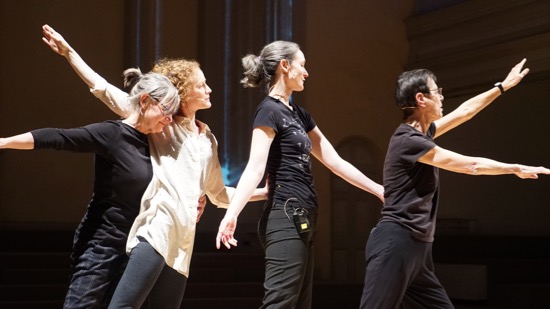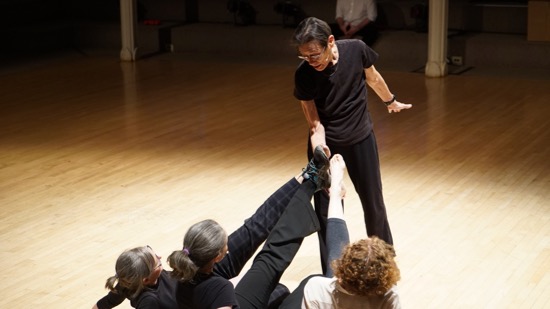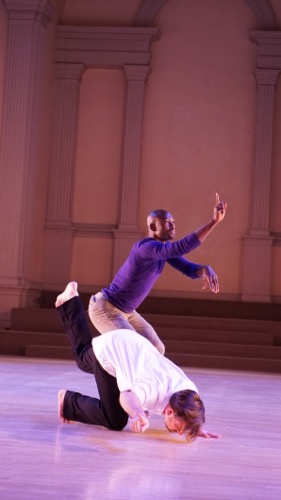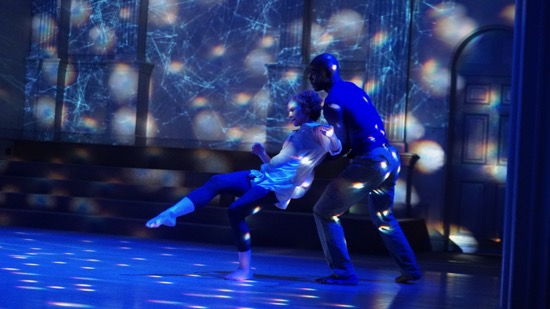Emily Coates’ Incarnations premieres at St. Marks’ Church, March 16 through 18.

Emily Coates’ Incarnations (dress rehearsal). Apollo leads the Muses. L to R: Iréne Hultman, Emily Coates, Sarah Demers, and Yvonne Rainer. Photo: Alexis Moh
I know how to re-wire a lamp. I aced high school physics (eventually). While researching Merce Cunningham and John Cage, I read Fritjof Capra’s The Tao of Physics, which fit the zeitgeist of the 1970s. But my brain has to struggle to keep its head above water, so to speak (a lousy metaphor) during Danspace Project’s presentation of Emily Coates’ Incarnations at St. Marks Church. Terms I hear swim in my mind, uniting or drifting by: “gravitational potential” and “quantum entanglement” act on me like unfamiliar drugs. “Inertia” and “torque” nudge me into thought.
Six years ago, Coates, once a member of the New York City Ballet and now teaching at Yale, teamed up with Dr. Sarah Demers, a professor of physics there. Together, they have taught workshops on physics and dance, created a video, Three Views of the Higgs and Dance (2013), and are working on a book. They present Incarnations as an elevated lecture-demonstration and address us with touching patience—and considerable charm—as if we were a class of semi-bright students. Newton’s laws of motion? Most of us know those. Particle physics? Not so much. When the Higgs Boson comes up (named after Higgs and Bose), I can’t help relating it to its sonic properties. Bos’n is how sailors pronounce boatswain, whose job is to keep everything shipshape and manage the crew. Maybe that’s more relevant than I think it is.
Coates and Demers are doing more than, say, relating gravity to Doris Humphrey’s guiding principle of Fall and Recovery and the Higgs Field to Merce Cunningam’s open-field stage picture. They start with Apollo, the title of George Balanchine’s 1928 ballet, and we can perhaps connect that to NASA’s eleven Apollo missions to the moon. One of the first sounds we hear is Balanchine’s voice talking about the dance, maybe with Stravinsky.
I should explain that I became a participant midway through Incarnations. Introducing the work, Coates asked if there were any physicists among the spectators. No? She considered other scientists. No. Sociologists? No. Finally she was down to anybody who’d taken a physics class, so feeling her pain, I raised my hand. The audience chatted while she coached Demers, me, and one other volunteer in four poses for the three Muses that Apollo is training in Balanchine’s ballet. On a given cue, later through the piece, we two spectators left our seats and joined Demers the altar platform. I have no idea what the audience gleaned from this, but I thought about channeling Jacques d’Amboise when a reduced number of seated muses raised their legs to touch my commanding hand. Was this, however, about particles decaying in space? Or were we bosons gaining mass by joining together?

Yvonne Rainer channels Balanchine’s Apollo in Emily Coates’ Incarnations. Muses (L to R): Iréne Hultman, Sarah Demers, and Emily Coates. Rehearsal photo: Alexis Moh
The work proper begins with a demonstration-discussion of Balanchine’s pirouette, examined in terms of principles of rotation. Coates demonstrates the pirouette preparation Balanchine learned as a boy in Russia: knees bent, feet turned out and apart in ballet’s fourth position; one curved arm meeting the other acts as a handle to start the turn. The axis of rotation passes from the ceiling through the body to the floor. Later, Balanchine did some thinking and re-designed the lift-off. Coates lunges, putting the weight over her bent front leg; her back leg is straight, one arm reaching ahead of her one slightly behind (a much lovelier position). The rear leg becomes the axis as she pushes backward onto it to turn and folds her arms close to her body. Demers watches and copies, like a beginning student (and gets corrections). Although Coates executes only a modest single pirouette, we imagine what torque she could achieve from the Balanchine preparation. It is, says Demers, like tightening a bolt with a long-handled wrench (perhaps, I think, in contrast to turning a screw with a screw driver).
The other performers—Lacina Coulibaly, Iréne Hultman, and Jon Kinzel—join in a much more convincing version of Apollo asserting his control over the Muses (beautiful how they raise their legs to the god’s hand one by one). But cardboard cartons come into play and images of inertia, mass, acceleration, and force. Music from Stravinsky’s masterly score for the ballet swell up and diminish. While Demers writes and explains equations on a whiteboard, such as F=ma (Newton’s Second Law), Coates offers interference, asking Demers to fall silent for four seconds from time to time, then to curl into a ball but continue talking, then to squat. In addition, a man (maybe Will Orzo, who composed part of the score) enters and shoves Demers across the space; she returns to her place, and he does it again. Force has accelerated mass out of inertia.
As dancing and a consideration of its physics unfold in a duet between Coulibaly and Kinzel, Demers asks an enigmatic question: “What if Newton fell in love with a pillow?” A pillow is produced, and the two men toss it back and forth. Kinzel collapses against it, and Coulibaly gently lowers him to the floor, cradling him. They also support each other, lay the pillow carefully down, and play ball with it. If no one catches it, it plops, like the apocryphal apple that hit Newton on the head. They also orbit each other, and Kinzel strikes a pose balancing on one knee, one hand, and his head that looks like an Apollo move tipped over.

Lacina Coulibaly (purple shirt) and Jon Kinzel in Emily Coates’ Incarnations. Photo: Alexis Moh
There’s no lack of dancing. At one point, Coates very handily performs, to Stravinsky’s music, the Balanchine solo in which the young Apollo comes into his own. Hultman dances a solo to Orzo’s low tones and glassy ones. She’s intent, as if this were an important task, and marvelously fluid and variegated. Coates starts her own dance, attempting to comply with such commands from Demers as “make it seem as if the air gets thick.” Toward the end of Incarnations, Kinzel performs a solo to an air from Bach’s Goldberg Variations; he’s as smooth, strong, and flexible as a pour of molasses. Coulibaly is revealed as an arresting and accomplished dancer. Very late in the work, two pairs perform duets in which they make contact in intriguing ways that I expect connect to a principle I should recognize.
Midway through Incarnations, a voice (can it be Apollo’s) sounds from the church balcony. “I shall now descend,” it says. And shortly, who should appear among us but Yvonne Rainer? Coates has been one of the “Raindeers” in recent works by this icon of postmodern dance and film, and Rainer’s guest appearance is astonishing. Weaving and staggering around the space as if buffeted by erratic winds, she unspools a dizzy, witty, ultra-smart stream-of-consciousness monologue, occasionally referring to a piece of paper she pulls out of a pocket. She is Apollo in decline, Apollo who can’t be in two places at once. She was too late getting to Beirut in 1975 to stop the war. She couldn’t get Ulysses home as quickly as Penelope hoped. And she’s a bit forgetful about names, referring to the “ladies on that island” and “that broad” that Agamemnon started the Trojan War to recover. She calls Achilles a heel to have fallen for the ploy.
It’s not easy getting Apollo’s chariot ready and the horses attached; also, reentering the gravitational field, they all burned up. One failure after another. Assad? Couldn’t stop him before everyone was dead or had fled. Obama didn’t understand what she was talking about. This exhausted Apollo relies on Imre Baraka for a final self-reassuring line: “What can I say? It is better to have loved and lost than to have put linoleum on your living room floor.” What a performance!

Emily Coates and Lacina Coulibaly in Emily Coates’ Incarnations. Photo: Alexis Moh
There’s a lot more talk of the speed of light, the Higgs field, particles, and more, with questions about what is at play in us when our particles decay. But something else very cosmic is happening in the church, engineered by Carol Mullins’s lighting and Yana Birÿkova’s projections, as well as by a film of an unidentified scientist lecturing about quantum physics. We’ve already heard/seen Demers talking and gesturing while Coates analyzes the gestures—an intellectual construct animating the body into some kind of equivalency. The hands belonging to the woman in the film, alone or together, are busy all the time, illustrating or emphasizing her words. In a mellow spotlight, Kinzel duplicates those gestures, perfectly in synch. But he is silent and has a dancer’s sensibility, so what he does seems resonant and subtly nuanced.
As he begins his Bach solo, and the others eventually feed into the dancing, and the talk about particle physics continues, something begins to happen to the film. First, the woman is outlined in white light and vibrating. Her image is gradually decaying and becoming something else. Little yellow dots swim on the walls, the floor, the film. After a while, the human figure has dissolved into what could be a subtly-hued Jackson Pollock painting in motion, but one consisting of similar tiny elements. Are we seeing particle decay? In other words, are the lecturer’s elementary particles transforming into other elementary particles, multiplying as they do so? At this point I’m overwhelmed. I can’t quite take in all the explanations, all the helpful examples. But somehow, as Stravinsky’s Apollon Musagète swells, I don’t mind. I’m probably multiplying and decaying every second. And I love seeing all the universal processes I don’t fully understand rendered lively, inevitable, quite beautiful, and worth thinking deeply about.

Sweet, very very sweet, Deborah, thank you.
I’m furious with you. I had tickets for the Thursday performance but was still engaged in plowing myself out. Thought to myself, oh well how interesting could it have been? I’m furious with you.